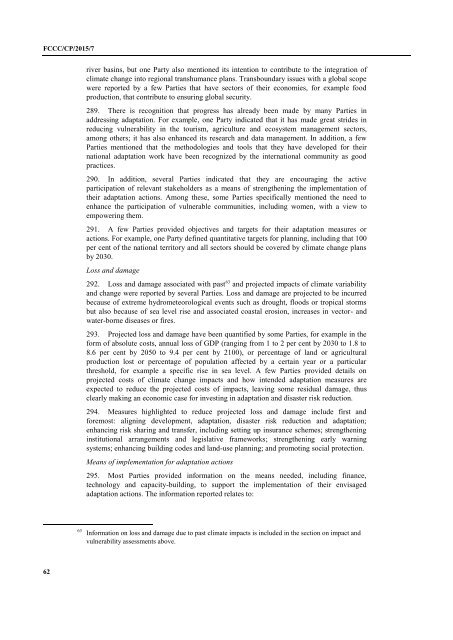FCCC/CP/2015/7
1PYuHQM
1PYuHQM
Create successful ePaper yourself
Turn your PDF publications into a flip-book with our unique Google optimized e-Paper software.
<strong>FCCC</strong>/<strong>CP</strong>/<strong>2015</strong>/7<br />
river basins, but one Party also mentioned its intention to contribute to the integration of<br />
climate change into regional transhumance plans. Transboundary issues with a global scope<br />
were reported by a few Parties that have sectors of their economies, for example food<br />
production, that contribute to ensuring global security.<br />
289. There is recognition that progress has already been made by many Parties in<br />
addressing adaptation. For example, one Party indicated that it has made great strides in<br />
reducing vulnerability in the tourism, agriculture and ecosystem management sectors,<br />
among others; it has also enhanced its research and data management. In addition, a few<br />
Parties mentioned that the methodologies and tools that they have developed for their<br />
national adaptation work have been recognized by the international community as good<br />
practices.<br />
290. In addition, several Parties indicated that they are encouraging the active<br />
participation of relevant stakeholders as a means of strengthening the implementation of<br />
their adaptation actions. Among these, some Parties specifically mentioned the need to<br />
enhance the participation of vulnerable communities, including women, with a view to<br />
empowering them.<br />
291. A few Parties provided objectives and targets for their adaptation measures or<br />
actions. For example, one Party defined quantitative targets for planning, including that 100<br />
per cent of the national territory and all sectors should be covered by climate change plans<br />
by 2030.<br />
Loss and damage<br />
292. Loss and damage associated with past 63 and projected impacts of climate variability<br />
and change were reported by several Parties. Loss and damage are projected to be incurred<br />
because of extreme hydrometeorological events such as drought, floods or tropical storms<br />
but also because of sea level rise and associated coastal erosion, increases in vector- and<br />
water-borne diseases or fires.<br />
293. Projected loss and damage have been quantified by some Parties, for example in the<br />
form of absolute costs, annual loss of GDP (ranging from 1 to 2 per cent by 2030 to 1.8 to<br />
8.6 per cent by 2050 to 9.4 per cent by 2100), or percentage of land or agricultural<br />
production lost or percentage of population affected by a certain year or a particular<br />
threshold, for example a specific rise in sea level. A few Parties provided details on<br />
projected costs of climate change impacts and how intended adaptation measures are<br />
expected to reduce the projected costs of impacts, leaving some residual damage, thus<br />
clearly making an economic case for investing in adaptation and disaster risk reduction.<br />
294. Measures highlighted to reduce projected loss and damage include first and<br />
foremost: aligning development, adaptation, disaster risk reduction and adaptation;<br />
enhancing risk sharing and transfer, including setting up insurance schemes; strengthening<br />
institutional arrangements and legislative frameworks; strengthening early warning<br />
systems; enhancing building codes and land-use planning; and promoting social protection.<br />
Means of implementation for adaptation actions<br />
295. Most Parties provided information on the means needed, including finance,<br />
technology and capacity-building, to support the implementation of their envisaged<br />
adaptation actions. The information reported relates to:<br />
63 Information on loss and damage due to past climate impacts is included in the section on impact and<br />
vulnerability assessments above.<br />
62


